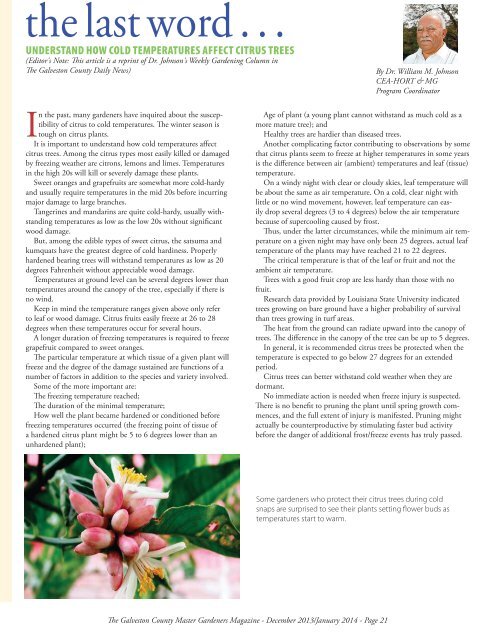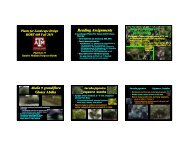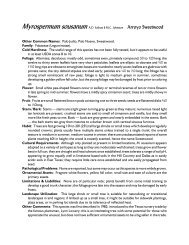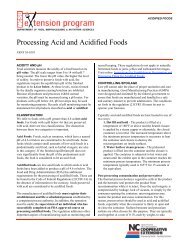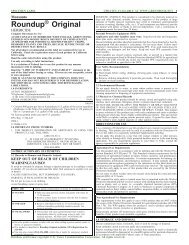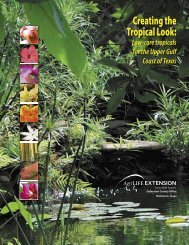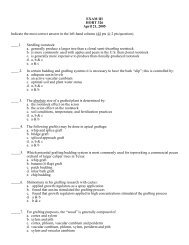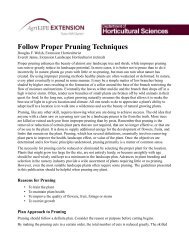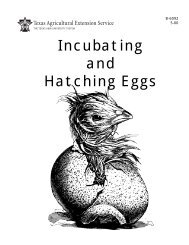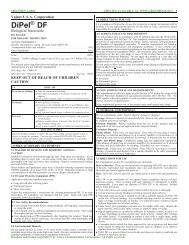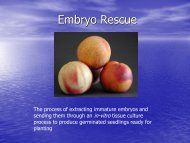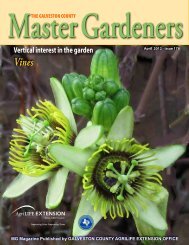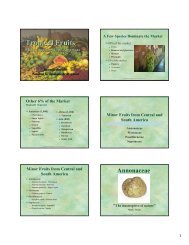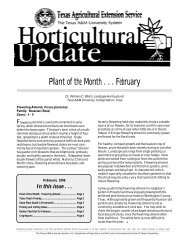Volunteer OpportunitiesTo volunteer for the MG Phone Desk contact Laura Bellmore bye-mail at galv3@wt.net or by calling the office at 281-534- 3413,ext 1.Libbie’s Place Adult Day Care has been designated as aDemonstration Garden for the Master Gardener Association. Itis located at 5402 Avenue U in Galveston and is part of MoodyMethodist Church outreach ministries (http://www.moody.org/libbies-place-senior-day-program). A crew is needed tomaintain and upgrade the garden as needed with your timespent counting towards MG volunteer hours. MG Pam Gilbertis heading up the crew and will determine the day, time andfrequency of the work days. If you are interested, or have anyquestions, please contact Pam at 409-771-5620 or by email atDrPGilbert@aol.com to let her know the day/times (AM/PM) thatwould work best for you. Thank you for your time andconsideration in this great new endeavor for the MasterGardeners.volunteers neededTour Guides for “First-Thursday-in-a-Month” Public Access & Tourof our Demonstration GardenLong-winded title but it says what we will be doing. OurDemonstration Garden will be open for touring by thegeneral public on the first Thursday of each month from 9:00to 11:00 a.m. MGs are needed to serve as tour guides for ourdemonstration Garden. Contact MG Julie Cartmill at 281-932-8896 or email evergreentreesinc@gmail.com or MG Bobbie Iveyat 713-748-8564 or email at blivey@sbcglobal.net to volunteer.Master Gardener Digital Photo Library CommitteeDo not be alarmed/dissuaded with the name of “committee!”If you like to organize things—join our newest volunteerendeavor known as the Master Gardener Digital Photo LibraryCommittee. The current weekly time schedule for this activityis every Thursday from 10 a.m.-12 noon. MG Sandra Devallwill be providing leadership for this. Volunteers will be addingphotographers’ names to digital photos for cataloging/sorting,sorting photos, or looking up botanical names. If any of thosetasks fit your interest—just show up and get with Sandra(281-534-3413, Ext. 17 or sandra.devall@co.galveston.tx.us)! ThePhoto Library has been the primary source for photos used inPowerPoint programs, website, publications, newsletters, etc.Volunteers are needed to help with the Saturday programs andthe Tuesday evening programs. If you can help please contactChristine Anastas (281) 468-3787 or Robert Marshall e-mailrbrtm01@att.netAgriLife Extension Office Demonstration Garden needsvolunteers! The gardens around the AgriLife Extension Officeare maintained by Master Gardeners under the team leadershipof MG Peggy Budny. This is an opportunity to make a goodimpression on the many visitors to the AgriLife Extension Office.Come out and have a good time while learning more aboutornamentals. Please contact Peggy at 281-334-7997 or by emailat fmbmab@verizon.net to find out the schedule and join herteam.volunteer hours logsTo report volunteer hours send your log sheets tomghours@wt.netbulletin boardspecialist & other MG RelatedtrainingPlease see the <strong>Texas</strong> Master Gardeners Website for details.Please note that if you go to the website you can findup-to-date information on Specialist Programs that wereadded in between editions of the newsletter. http://www.texasmastergardeners.com. You may download theapplication forms from that website. Note that all applicationsfor the Specialist Training courses must be approved andsigned by Dr. William Johnson. Note that fees do not includelodging or food unless specified otherwise.Educational Tour with Doug Welsh to SOUTH AFRICAFebruary 15-26, 2014Join Doug Welsh and explore the lush gardens ofJohannesburg, South Africa’s stunning national parks andthe gorgeous flora of Cape Town. In addition, you’ll discoverthe dramatic landscape of the Cape of Good Hope, sip winesin South Africa’s premier wine region, and stay in the Dutchcolonial town of Stellenbosch. Your journey will culminate atthe Bakubung Bush Lodge where you’ll ride into the bush inan open safari vehicle with Swazi trackers and African rangersfor an intimate viewing of South Africa’s lions, leopards, rhinosand elephants.For more information, call Earthbound Expeditions at 800-723-8454, email at info@earthboundexpeditions.com, or visithttp://www.earthboundexpeditions.com/february-2014-south-africa-with-doug-welshthe photography groupThe Photography Group meets on the second Wednesdayof each month at 1:30 pm at the Extension Office at CarbidePark. This photography group is open to all Master Gardenersand Master Naturalists for fun, learning and practice ofphotography. Pictures are submitted to the MG/MN databasefor use in publications and lectures.need a gift?The following Master Gardener award-winning publicationsare on sale. Stop by the Extension Office to pick them up foryourself or for gift-giving.The Butterflies of Galveston CountyThumbnail Guide to <strong>Gardening</strong> for New GardenersAmbrosia from Your Back YardBilingual Guide to Yard CareHerbs for the Upper Gulf Coast of <strong>Texas</strong>Our Edible LandscapeCreating the Tropical LookThe Galveston County Master Gardeners Magazine - December 2013/January 2014 - Page 20
the last word . . .Understand How Cold Temperatures Affect Citrus Trees(Editor's Note: This article is a reprint of Dr. Johnson's Weekly <strong>Gardening</strong> Column inThe Galveston County Daily News)By Dr. William M. JohnsonCEA-HORT & MGProgram CoordinatorIn the past, many gardeners have inquired about the susceptibilityof citrus to cold temperatures. The winter season istough on citrus plants.It is important to understand how cold temperatures affectcitrus trees. Among the citrus types most easily killed or damagedby freezing weather are citrons, lemons and limes. Temperaturesin the high 20s will kill or severely damage these plants.Sweet oranges and grapefruits are somewhat more cold-hardyand usually require temperatures in the mid 20s before incurringmajor damage to large branches.Tangerines and mandarins are quite cold-hardy, usually withstandingtemperatures as low as the low 20s without significantwood damage.But, among the edible types of sweet citrus, the satsuma andkumquats have the greatest degree of cold hardiness. Properlyhardened bearing trees will withstand temperatures as low as 20degrees Fahrenheit without appreciable wood damage.Temperatures at ground level can be several degrees lower thantemperatures around the canopy of the tree, especially if there isno wind.Keep in mind the temperature ranges given above only referto leaf or wood damage. Citrus fruits easily freeze at 26 to 28degrees when these temperatures occur for several hours.A longer duration of freezing temperatures is required to freezegrapefruit compared to sweet oranges.The particular temperature at which tissue of a given plant willfreeze and the degree of the damage sustained are functions of anumber of factors in addition to the species and variety involved.Some of the more important are:The freezing temperature reached;The duration of the minimal temperature;How well the plant became hardened or conditioned beforefreezing temperatures occurred (the freezing point of tissue ofa hardened citrus plant might be 5 to 6 degrees lower than anunhardened plant);Age of plant (a young plant cannot withstand as much cold as amore mature tree); andHealthy trees are hardier than diseased trees.Another complicating factor contributing to observations by somethat citrus plants seem to freeze at higher temperatures in some yearsis the difference between air (ambient) temperatures and leaf (tissue)temperature.On a windy night with clear or cloudy skies, leaf temperature willbe about the same as air temperature. On a cold, clear night withlittle or no wind movement, however, leaf temperature can easilydrop several degrees (3 to 4 degrees) below the air temperaturebecause of supercooling caused by frost.Thus, under the latter circumstances, while the minimum air temperatureon a given night may have only been 25 degrees, actual leaftemperature of the plants may have reached 21 to 22 degrees.The critical temperature is that of the leaf or fruit and not theambient air temperature.Trees with a good fruit crop are less hardy than those with nofruit.Research data provided by Louisiana State <strong>University</strong> indicatedtrees growing on bare ground have a higher probability of survivalthan trees growing in turf areas.The heat from the ground can radiate upward into the canopy oftrees. The difference in the canopy of the tree can be up to 5 degrees.In general, it is recommended citrus trees be protected when thetemperature is expected to go below 27 degrees for an extendedperiod.Citrus trees can better withstand cold weather when they aredormant.No immediate action is needed when freeze injury is suspected.There is no benefit to pruning the plant until spring growth commences,and the full extent of injury is manifested. Pruning mightactually be counterproductive by stimulating faster bud activitybefore the danger of additional frost/freeze events has truly passed.Some gardeners who protect their citrus trees during coldsnaps are surprised to see their plants setting flower buds astemperatures start to warm.The Galveston County Master Gardeners Magazine - December 2013/January 2014 - Page 21


